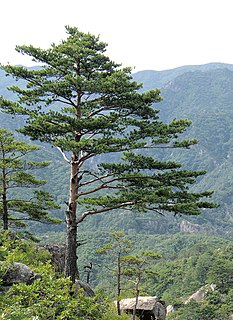
A pine is any conifer in the genus Pinus of the family Pinaceae. Pinus is the sole genus in the subfamily Pinoideae. The Plant List compiled by the Royal Botanic Gardens, Kew and Missouri Botanical Garden accepts 126 species names of pines as current, together with 35 unresolved species and many more synonyms.

Eucalyptus regnans, known variously as mountain ash, swamp gum, or stringy gum, is a species of Eucalyptus native to Tasmania and the state of Victoria in southeastern Australia. It is the tallest flowering plant and one of the tallest trees in the world, second only to the coast redwood of North America. A straight-trunked tree with smooth grey bark, but with a stocking of rough brown bark from 5 to 20 metres above the ground, it regularly grows to 85 metres (280 ft), with the tallest living specimen, the Centurion in Tasmania, standing 100.5 metres tall. White flowers appear in autumn. Victorian botanist Ferdinand von Mueller described the species in 1871.

Taxodium is a genus of one to three species of extremely flood-tolerant conifers in the cypress family, Cupressaceae. The generic name is derived from the Latin word taxus, meaning "yew", and the Greek word εἶδος (eidos), meaning "similar to." Within the family, Taxodium is most closely related to Chinese swamp cypress and sugi.

Fraxinus excelsior, known as the ash, or European ash or common ash to distinguish it from other types of ash, is a flowering plant species in the olive family Oleaceae. It is native throughout mainland Europe east to the Caucasus and Alborz mountains. The northernmost location is in the Trondheimsfjord region of Norway. The species is widely cultivated and reportedly naturalised in New Zealand and in scattered locales in the United States and Canada.

Pinus radiata, family Pinaceae, the Monterey pine, insignis pine or radiata pine, is a species of pine native to the Central Coast of California and Mexico.

Pinus strobus, commonly denominated the eastern white pine, northern white pine, white pine, Weymouth pine (British), and soft pine is a large pine native to eastern North America. It occurs from Newfoundland, Canada west through the Great Lakes region to southeastern Manitoba and Minnesota, United States, and south along the Appalachian Mountains and upper Piedmont to northernmost Georgia and perhaps very rarely in some of the higher elevations in northeastern Alabama.

Magnolia acuminata, commonly called the cucumber tree, cucumber magnolia or blue magnolia, is one of the largest magnolias, and one of the cold-hardiest. It is a large forest tree of the Eastern United States and Southern Ontario in Canada. It is a tree that tends to occur singly as scattered specimens, rather than in groves.

Eucalyptus diversicolor, commonly known as the karri, is a eucalypt native to the wetter regions of southwestern Western Australia.

Pinus halepensis, commonly known as the Aleppo pine, also known as Jerusalem's oren, is a pine native to the Mediterranean region. Its range extends from Morocco, Algeria and Spain north to southern France, Italy, Croatia, Montenegro, Albania, and east to Greece, all over Malta and northern Tunisia, with an outlying population in Syria, Lebanon, southern Turkey, Jordan, Israel, and Palestinian territories.

Tsuga heterophylla, the western hemlock or western hemlock-spruce, is a species of hemlock native to the west coast of North America, with its northwestern limit on the Kenai Peninsula, Alaska, and its southeastern limit in northern Sonoma County, California.

Mesua ferrea, the Sri Lankan ironwood, Indian rose chestnut, or cobra's saffron, is a species in the family Calophyllaceae. This slow-growing tree is named after the heaviness and hardness of its timber. It is widely cultivated as an ornamental due to its graceful shape, grayish-green foliage with a beautiful pink to red flush of drooping young leaves, and large, fragrant white flowers. It is native to wet, tropical parts of Sri Lanka, India, southern Nepal, Burma, Thailand, Indochina, the Philippines, Malaysia and Sumatra, where it grows in evergreen forests, especially in river valleys. In the eastern Himalayas and Western Ghats in India it grows up to altitudes of 1,500 m (4,900 ft), while in Sri Lanka up to 1,000 m (3,300 ft). It is national tree of Sri Lanka and state flower of Tripura and Mizoram.

Peltogyne, commonly known as purpleheart, amendoim, violet wood, amaranth and other local names is a genus of 23 species of flowering plants in the family Fabaceae; native to tropical rainforests of Central and South America; from Guerrero, Mexico, through Central America, and as far as south-eastern Brazil.

Dyera costulata, the jelutong, is a species of tree in the oleander subfamily. It grows to approximately 60 metres (200 ft) tall with diameters of 2 metres, or even to 80 m (260 ft) tall with diameters to 3 m (10 ft), and boles clear and straight for 30 m (90 ft). It grows in Malaysia, Borneo, Sumatra and southern Thailand. Its natural distribution is scattered locales in low-elevation tropical evergreen forest.

Dalbergia sissoo, known commonly as North Indian rosewood, is a fast-growing, hardy deciduous rosewood tree native to the Indian Subcontinent and Southern Iran. D. Sissoo is a large, crooked tree with long, leathery leaves and whitish or pink flowers.
Gilbertiodendron is a genus of legume in the family Fabaceae.

Mimusops elengi is a medium-sized evergreen tree found in tropical forests in South Asia, Southeast Asia and northern Australia. English common names include Spanish cherry, medlar, and bullet wood. Its timber is valuable, the fruit is edible, and it is used in traditional medicine. As the trees give thick shade and flowers emit fragrance, it is a prized collection of gardens.

Heritiera fomes is a species of mangrove tree in the family Malvaceae. Its common names include sunder, sundri, jekanazo and pinlekanazo. It is the dominant mangrove tree species of the Sundarbans of Bangladesh and India, and comprises about 70% of the trees in the area. H. fomes is a major timber-producing tree. It is threatened by over-harvesting, water diversions in the Ganges Basin, fluctuations in salinity due to upstream and coastal development and top dying disease. The International Union for Conservation of Nature has assessed it as being "endangered".

Pseudotsuga menziesii var. menziesii, also known as coast Douglas-fir, Pacific Douglas-fir, Oregon pine, or Douglas spruce, is an evergreen conifer native to western North America from west-central British Columbia, Canada southward to central California, United States. In Oregon and Washington its range is continuous from the Cascades crest west to the Pacific Coast Ranges and Pacific Ocean. In California, it is found in the Klamath and California Coast Ranges as far south as the Santa Lucia Mountains with a small stand as far south as the Purisima Hills, Santa Barbara County. In the Sierra Nevada it ranges as far south as the Yosemite region. It occurs from near sea level along the coast to 1,800 metres (5,900 ft) in the California Mountains. Further inland, coast Douglas-fir is replaced by Rocky Mountain or interior Douglas-fir. Interior Douglas-fir intergrades with coast Douglas-fir in the Cascades of northern Washington and southern British Columbia.

Strophanthus preussii, Preuss' strophanthus, is an evergreen liana up to 12 metres (39 ft) long or a shrub up to 5 metres (16 ft) tall, with a stem diameter up to 2.5 centimetres (1 in). Its fragrant flowers feature a white to orange corolla, red-striped or spotted on the inside. Corollas have very long tails. Vernacular names for the plant include "spider tresses" and "poison arrow vine". Habitats are forested areas from sea level to 1,400 metres (4,600 ft) altitude. Traditional medicinal uses of S. preussii include treatment of gonorrhoea and healing of sores. The plant has also been used as arrow poison. Strophanthus preussii is native to countries of west and central tropical Africa.
Humbertia madagascariensis is a species of tree in the morning glory family, known in French as bois de fer; it is endemic to southeastern Madagascar where it occurs in humid evergreen forests at altitudes up to about 600 m (2,000 ft).



















